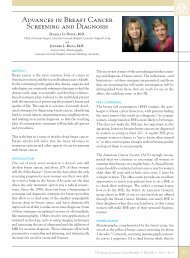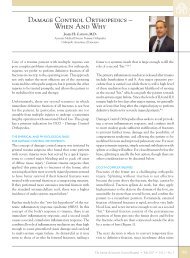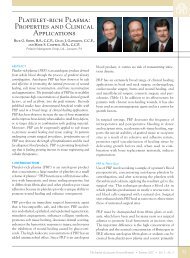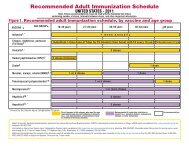Evidence-Based Management of Severe Sepsis and Septic Shock
Evidence-Based Management of Severe Sepsis and Septic Shock
Evidence-Based Management of Severe Sepsis and Septic Shock
Create successful ePaper yourself
Turn your PDF publications into a flip-book with our unique Google optimized e-Paper software.
evidence-based management<br />
the pro-infl ammatory, pro-coagulant milieu <strong>of</strong> sepsis.<br />
Drotrecogin alfa inhibits endothelial cell activation <strong>and</strong><br />
apoptosis, <strong>and</strong> is an inhibitor <strong>of</strong> tumor necrosis factor.<br />
It is administered as a continuous 96 hour infusion at a<br />
rate <strong>of</strong> 24 mcg/kg/hr.<br />
The pivotal study for this compound was the PROWESS<br />
trial (18), a multi-national, blinded, r<strong>and</strong>omized,<br />
placebo-controlled trial that evaluated 1690 patients<br />
with severe sepsis or septic shock. Patients were r<strong>and</strong>omized<br />
to rhAPC or placebo within 24 hours <strong>of</strong> admission.<br />
Treated patients had lower 28 day mortality (24.7% vs.<br />
30.8%, p < 0.01), demonstrated more rapid recovery<br />
from cardiovascular <strong>and</strong> pulmonary dysfunction (p =<br />
0.009), <strong>and</strong> had signifi cantly lower sequential organ<br />
failure assessment scores (p = 0.022). Post hoc analysis<br />
demonstrated benefit only for patients with APACHE II<br />
scores >25, as reflected in the initial FDA indication for<br />
this drug. There was an increased risk <strong>of</strong> serious bleeding,<br />
including fatal CNS hemorrhage in the treatment group<br />
that did not reach statistical signifi cance.<br />
This trial was criticized for a study protocol modifi cation<br />
after 720 patients had been enrolled that excluded<br />
patients with certain co-morbidities, such as organ transplants,<br />
patients with metastatic cancer, <strong>and</strong> pancreatitis.<br />
In addition, the master cell line used to produce rhAPC<br />
was changed during the study, with a greater benefi t in<br />
patients enrolled later in the study.<br />
A second open label, single arm trial (ENHANCE) was<br />
subsequently performed (19), <strong>and</strong> a mortality benefi t<br />
similar to PROWESS was again demonstrated. In addition,<br />
patients treated within 24 hours after the first<br />
sepsis-induced organ dysfunction had a lower mortality<br />
(22.9% vs. 27.4%).<br />
The ADDRESS trial was an investigation <strong>of</strong> the use <strong>of</strong><br />
rhAPC in lower risk patients (20), defined as having an<br />
APACHE II score <strong>of</strong> 25 <strong>and</strong> multiple organ failure who do<br />
not meet any <strong>of</strong> the extensive exclusion criteria for this<br />
drug. Limitation <strong>of</strong> use in patients with only one organ<br />
dysfunction or recent surgery also seems prudent.<br />
GLUCOSE CONTROL<br />
Hyperglycemia <strong>and</strong> insulin resistance are common in<br />
ICU patients, even in the absence <strong>of</strong> underlying diabetes<br />
mellitus. In a study <strong>of</strong> intensive insulin therapy in<br />
post-operative surgical patients, aggressive control <strong>of</strong><br />
hyperglycemia to maintain values <strong>of</strong> 80-110 mg/dl utilizing<br />
a continuous insulin drip demonstrated a reduction<br />
in mortality from 8.0% to 4.6% for treated patients (21).<br />
In addition, reductions were observed in the prevalence <strong>of</strong><br />
progression <strong>of</strong> renal failure to dialysis, ICU polyneuropathy,<br />
transfusion requirements, need for ventilator support,<br />
<strong>and</strong> blood stream infections. Significant hypoglycemia,<br />
however, complicated the intensive therapy group. Post<br />
hoc analysis demonstrated that a significant benefit was<br />
still accrued in patients with less aggressive glucose target<br />
values











